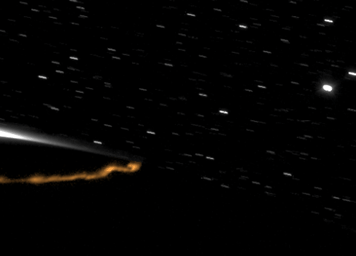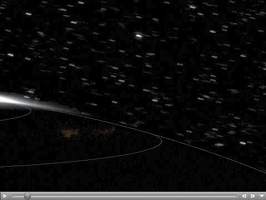
|
Northern Aurora in Motion
- Click the image above for a larger view
 Movie Download Options
Movie Download Options- Full-Res JPEG (480 x 345) (9.2 kB)
- Full-Res TIFF (480 x 345) (497.6 kB)
Caption:

Click on the image for non-narrated animation
Saturn's Aurora in a New Light (narrated)
An aurora, shining high above the northern part of Saturn, moves from the night side to the day side of the planet in this movie recorded by Cassini.
These observations, taken over four days, represent the first visible-light video of Saturn's auroras. They show tall auroral curtains, rapidly changing over time when viewed at the limb, or edge, of the planet's northern hemisphere. The sequence of images also reveals that Saturn's auroral curtains, the sheet-like formations of light-emitting atmospheric molecules, stretch up along Saturn's magnetic field and reach heights of more than 1,200 kilometers (746 miles) above the planet's limb. These are the tallest known "northern lights" in the solar system.
These auroral displays are created by charged particles from the magnetosphere that plunge into the planet's upper atmosphere and cause it to glow. The magnetosphere is the region of electrically charged particles that are trapped in the magnetic field of the planet. The auroral curtains shown in the movie reveal the paths that these charged particles take as they flow along lines of the magnetic field between the planet's magnetosphere and ionosphere.
The day side of Saturn scatters light toward Cassini, creating the overexposed triangle at the center of the left of the frame. Stars can be seen above the limb of the planet, trailing across the field of view.
The images were captured in black and white, but the aurora in this movie is shown in a false orange color to distinguish it from background noise in the images. The images were processed to remove cosmic ray hits, bad pixels and lens flare. On Earth, auroras often appear green, but scientists do not yet know the color of auroras on Saturn. Auroras on Saturn, like those on Earth, appear mostly in the high latitudes near the planet's poles. In the annotated version of the movie, latitude lines have been drawn on the planet at 70 and 78 degrees north latitude. The auroras can be seen moving with the planet's rotation along the curved path of about 74 degrees north latitude. They change shape and brightness in a manner similar to terrestrial auroras. The aurora curtains become particularly bright when they are projected edge-on to Cassini as they pass over the limb from the near (dark) side to the far (bright) side of Saturn. Near the end of the movie, a snake-shaped aurora footprint brightens abruptly and fades over about five frames.
The movie consists of 472 images taken during an 81-hour period. Each image was obtained with a two- or three-minute exposure.
These images were taken in visible light with the Cassini spacecraft's narrow-angle camera on Oct. 5 to 8, 2009. The view was acquired at a distance of approximately 2.8 million kilometers (1.7 million miles) from Saturn and at a Sun-Saturn-spacecraft, or phase, angle of 111 degrees. Image scale is 32 kilometers (20 miles) per pixel.
Background Info:
The Cassini-Huygens mission is a cooperative project of NASA, the European Space Agency and the Italian Space Agency. The Jet Propulsion Laboratory, a division of the California Institute of Technology in Pasadena, manages the mission for NASA's Science Mission Directorate, Washington, D.C. The Cassini orbiter and its two onboard cameras were designed, developed and assembled at JPL. The imaging operations center is based at the Space Science Institute in Boulder, Colo.
For more information about the Cassini-Huygens mission visit http://saturn.jpl.nasa.gov/ . The Cassini imaging team homepage is at http://ciclops.org .
Cataloging Keywords:
| Name | Value | Additional Values |
|---|---|---|
| Target | Saturn | |
| System | Saturn | |
| Target Type | Planet | |
| Mission | Cassini-Huygens | |
| Instrument Host | Cassini Orbiter | |
| Host Type | Orbiter | |
| Instrument | Imaging Science Subsystem (ISS) | |
| Detector | Narrow Angle Camera | |
| Extra Keywords | Atmosphere, Color, Magnetosphere, Movie, Rotation, Visual | |
| Acquisition Date | ||
| Release Date | 2009-11-24 | |
| Date in Caption | ||
| Image Credit | NASA/JPL/Space Science Institute | |
| Source | photojournal.jpl.nasa.gov/catalog/PIA11681 | |
| Identifier | PIA11681 | |
